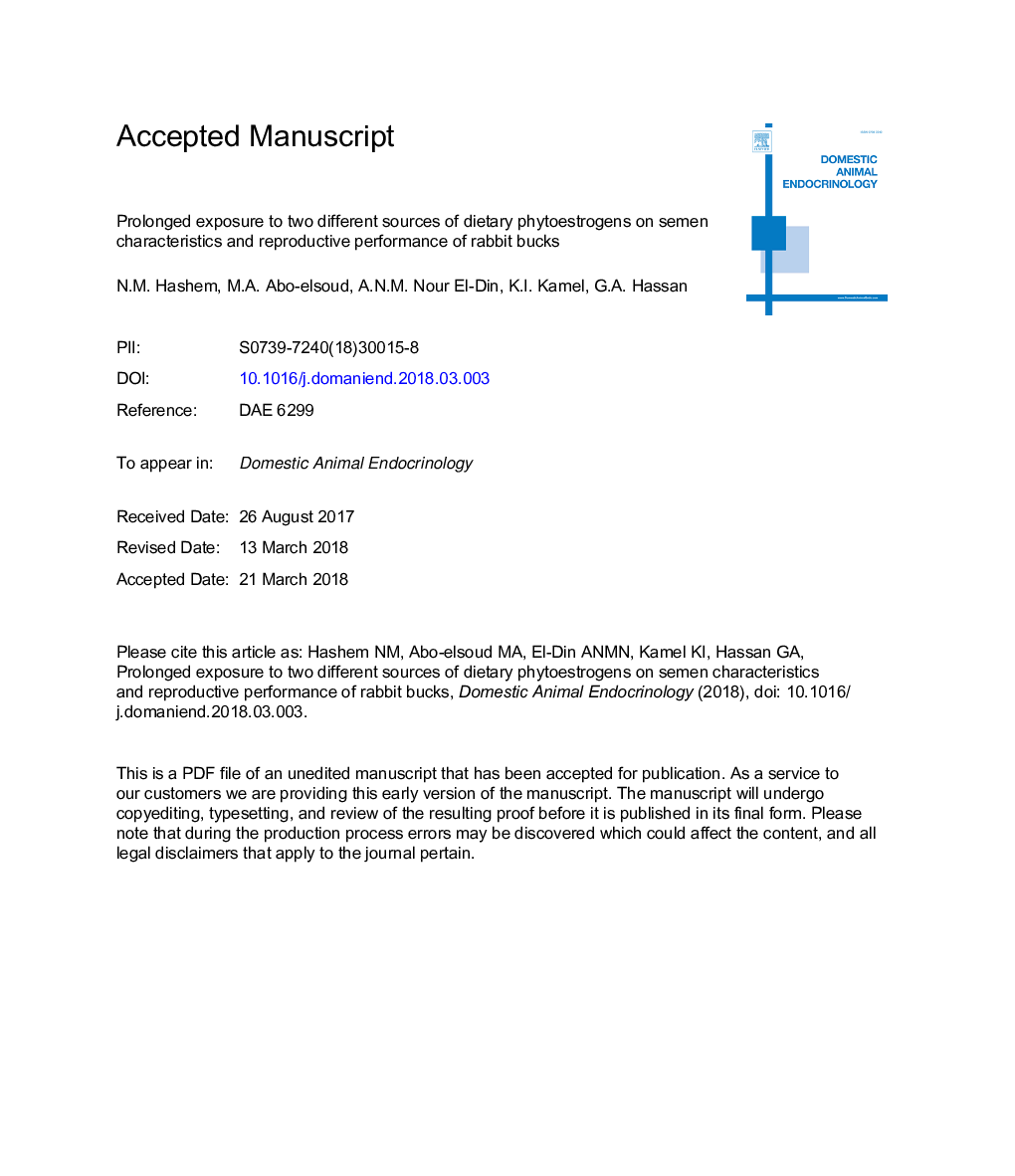| کد مقاله | کد نشریه | سال انتشار | مقاله انگلیسی | نسخه تمام متن |
|---|---|---|---|---|
| 8481919 | 1551495 | 2018 | 27 صفحه PDF | دانلود رایگان |
عنوان انگلیسی مقاله ISI
Prolonged exposure of dietary phytoestrogens on semen characteristics and reproductive performance of rabbit bucks
ترجمه فارسی عنوان
قرار گرفتن در معرض طولانی مدت فیتواستروژن های رژیمی بر خصوصیات اسپرم و عملکرد تولید مثل خرگوش ها
دانلود مقاله + سفارش ترجمه
دانلود مقاله ISI انگلیسی
رایگان برای ایرانیان
کلمات کلیدی
فیتواستروژن، استرس اکسیداتیو، کیفیت اسپرم، باروری، خرگوش نر
موضوعات مرتبط
علوم زیستی و بیوفناوری
علوم کشاورزی و بیولوژیک
علوم دامی و جانورشناسی
چکیده انگلیسی
The effects of inclusion of different sources of dietary phytoestrogens on antioxidant capacity, hormonal balance, libido, semen quality, and fertility of rabbit bucks were studied. Twenty-one, adult, fertile, V-line bucks were randomly allocated into 3 homogenous groups (n = 7/treatment) and received control diet (phytoestrogens-free diet, CON) or soybean meal isoflavones-containing diet (SMI) or linseed meal lignans-containing diet (LML) for 12 wk. The diets were formulated to be isocaloric and isonitrogenous. The concentrations of isoflavones in the SMI diet were 24.04 mg/100 g dry matter (DM) daidzein and 13.10 mg/100 g DM genistein. The major phytoestrogen detected in the LML diet was secoisolariciresinol (36.80 mg/100 g DM). Treatment had no effects on body weight, feed intake and rectal temperature of bucks. Compared with control, bucks fed the SMI and LML diets had higher (P < 0.001) blood plasma total antioxidant capacity (0.98 ± 0.12, 1.50 ± 0.13, and 2.29 ± 0.17 mM/L for CON, SMI, and LML, respectively), and lower (P < 0.01) blood plasma malondialdehyde (2.76 ± 0.23, 1.76 ± 0.16, and 1.70 ± 0.18 nmol/mL for CON, SMI, and LML, respectively), whereas activities of reduced glutathione and superoxide dismutase (SOD) enzymes were not affected. Bucks fed the SMI and LML diets had greater (P < 0.001) concentrations of blood plasma triiodothyronine. Feeding the SMI and LML diets decreased (P < 0.01) libido (8.26 ± 0.71, 12.18 ± 0.97, and 14.12 ± 1.12 s for CON, SMI, and LML, respectively), sperm concentration (327.7 ± 21.6, 265.8 ± 36.8, and 226.5 ± 20.1 à 106/mL for CON, SMI, and LML, respectively), testosterone (5.16 ± 0.95, 3.91 ± 0.63, and 3.04 ± 0.92 ng/mL for CON, SMI, and LML, respectively), and seminal plasma fructose compared with the CON diet. The percentage of progressive motile sperm was improved (P < 0.001) by both phytoestrogen-containing diets. Feeding the SMI diet increased (P = 0.02) the percentage of live sperm compared with CON, whereas LML resulted in an intermediate value. Dietary treatment of bucks did not affect kindling rates or litter sizes of does, and did not affect birth weights or viabilities of kits. In conclusion, prolonged consumption of dietary isoflavones or lignans did not impair semen fertilizability. This may be due to the benefits of antioxidant activity or due to the benefits of other components in the diet. Dietary phytoestrogens did evoke obvious decreases in libido and steroidogenesis with altered semen parameters.
ناشر
Database: Elsevier - ScienceDirect (ساینس دایرکت)
Journal: Domestic Animal Endocrinology - Volume 64, July 2018, Pages 84-92
Journal: Domestic Animal Endocrinology - Volume 64, July 2018, Pages 84-92
نویسندگان
N.M. Hashem, M.A. Abo-elsoud, A.N.M. Nour El-Din, K.I. Kamel, G.A. Hassan,
